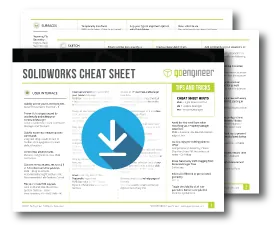Exploded Views for SOLIDWORKS Multibody Parts
In SOLIDWORKS, using a multibody part instead of an assembly can be beneficial in specific circumstances, such as increased performance over assemblies, bulk configuration creation, and sheet metal/weldment work. Multibody parts are especially useful when you have a bill of materials but no moving parts. If there are no kinematics to evaluate, the “assembly” can remain a multibody part.
Exploded views in assemblies are common enough (to learn more, visit our blog on how to make exploded views in an assembly). But many SOLIDWORKS users are unaware that exploded views can also be created for multibody parts. This blog post will quickly go over how to add these exploded views, how they differ from the assembly exploded views, and how you can reuse the part-level exploded view in a new assembly if necessary.
Creating Multibody Part Exploded View
SOLIDWORKS users have multiple avenues to create an exploded view at the part level. But, unlike the Assembly environment, the button to create an exploded view is not immediately visible on the CommandManager.
To launch the Exploded View option, right-click the active configuration and select New Exploded View.

The Exploded View command can also be found in the Insert menu.

Or, you can search for the Exploded View command in the Command Search Bar.

When you create your first exploded view, it will automatically be added as a derived configuration to the “default” configuration. Using a derived configuration is preferable, as you will not be suppressing any features or configuring any dimensions. Additionally, further changes made to the solid bodies or the part in general will also apply to the derived exploded view.
Exploded View Command
After launching the Exploded View command, a similar interface to the Assembly Exploded View will appear in the PropertyManager, allowing Explode Steps to be added. From this interface, you can select individual bodies or selections of bodies by holding the CTRL key and dragging them along the XYZ coordinate system using the orange arrows. For each selection, the direction and distance can be modified in the Settings section on the left side of the PropertyManager.

You also have the option to Auto-Space selections of solid bodies in the Options section, allowing for quick and intuitive, uniform spacing between them. Each step is added to the Explode Steps box after hitting Apply, and these steps can be modified or deleted from this interface. After adding all the necessary Explode Steps, clicking the green check will save this new exploded view under the Exploded Configuration. It can be toggled on and off by right-clicking the new “Exploded View1”.
Exploded View Lines
You can also add exploded lines in an equivalent way to the Assembly environment. Similar to Exploded View, the Explode Line Sketch command can be found either through the Insert menu or by searching in the Command Search Bar.
Launch the Route Line tool to select items to connect in the graphics area. Keep adding these lines until you exit the command with the green check. Options to reverse and change the line's orthogonal direction exist in the Route Line Tool command.
Please note that smart explode lines are not available in a multibody part as they are in an assembly.

Comparison to Assembly Explode View
While the Exploded View interface and general function are similar between the multibody part and assembly versions, there are some key limitations present in the Part environment. First, in an Assembly, you can reorient the coordinate plane using the white center dot of the direction triad. At the Part level, however, it is required to use the orientation box in the Settings section. You are also restricted from rotating each body, so you lack the option to toggle rotation rings and cannot use the radial steps option present in the Assembly environment.

Reuse Exploded Views
Previously, you would need to create a new Exploded View if you converted your multibody part into an Assembly. However, starting in 2020, SOLIDWORKS provides the option to reuse existing views in a new assembly.
After creating your multibody part and its exploded view, you can then add said part to an Assembly and create another Exploded View in the Assembly environment. At the bottom of the PropertyManager, click Reuse Explode: From Part to import the previously created exploded view as a new step in the Assembly (further steps can then be added as well).

Conclusion
While the Exploded View tool is most often used in the Assembly environment, it can be beneficial to use at the Part level, especially for sheet metal and weldment parts, which automatically create separate bodies.
While not all the functionality is carried over at the Part level, the fundamental elements are the same between the two, and SOLIDWORKS has ensured that multibody part Exploded Views can be carried into the Assembly if more control is needed.
Want to learn more? Check out more SOLIDWORKS tutorials below. Additionally, join the GoEngineer Community to create forum posts, enter design contests, and answer questions from other SOLIDWORKS users.

SOLIDWORKS CAD Cheat Sheet
SHORTCUTS ⋅ MOUSE GESTURES ⋅ HOT KEYS
Our SOLIDWORKS CAD Cheat Sheet, featuring over 90 tips and tricks, will help speed up your process.
Learn More
Faster DWG Conversions Using the SOLIDWORKS 2D to 3D Toolbar
Create Custom Weldment Profiles in SOLIDWORKS
SOLIDWORKS Paragraph Properties Guide
Mastering Basic Part Modeling in SOLIDWORKS: A Step-by-Step Guide

About Brandon McGoey
Brandon McGoey is a SOLIDWORKS Application Engineer based out of San Diego, CA. Coming from an Education and Instructional Design background since 2020, he teaches new users of the software Essentials and Advanced functionality. He earned his Bachelors in Mechanical Engineering from San Diego State, and enjoys 3D printing as a hobby.
Get our wide array of technical resources delivered right to your inbox.
Unsubscribe at any time.